
William McMaster Murdoch, RNR was a Scottish sailor, who served as a Lieutenant in the Royal Navy Reserve and was the first officer on the RMS Titanic. He was the officer in charge on the bridge when the Titanic collided with an iceberg, and was amongst the 1,500 people who died when the ship sank. The circumstances of his death have been the subject of controversy.

Violet Constance Jessop was an Irish-Argentine ocean liner stewardess and nurse in the early 20th century. Jessop is best known for having survived the sinking of both the RMS Titanic in 1912 and her sister ship the HMHS Britannic in 1916, as well as having been onboard the eldest of the three sister ships, the RMS Olympic, when it collided with the British warship HMS Hawke in 1911.
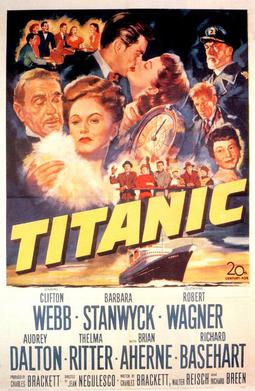
Titanic is a 1953 American drama film directed by Jean Negulesco, and starring Clifton Webb and Barbara Stanwyck. It centers on an estranged couple and other fictional passengers on the ill-fated maiden voyage of the RMS Titanic, which took place in April 1912.

Titanic is a 1943 German propaganda film made during World War II in Berlin by Tobis Productions for UFA, depicting the catastrophic sinking of RMS Titanic in 1912. This was the third German language dramatization of the event, following a silent film released in 1912 just four months after the sinking and the British produced German film Atlantik released in 1929.

Futility is a novella written by Morgan Robertson, first published in 1898. It was revised as The Wreck of the Titan in 1912. It features a fictional British ocean liner named Titan that sinks in the North Atlantic Ocean after striking an iceberg. The Titan and its sinking are famous for similarities to the passenger ship RMS Titanic and its sinking 14 years later. After the sinking of the Titanic the novel was reissued with some changes, particularly to the ship's displacement.
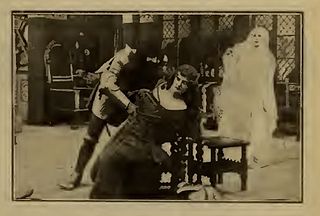
Das Mirakel is a black-and white silent German film made and released in 1912, directed by Mime Misu for the Berlin film production company Continental-Kunstfilm GmbH. It was based on Karl Vollmoeller's 1911 play, The Miracle. The film was originally advertised as The Miracle in Britain and the US, but after copyright litigation in both countries it was shown as Sister Beatrix and Sister Beatrice respectively. In Germany it was known as Das Marienwunder: eine alte Legende.

Saved from the Titanic was a 1912 American silent short film starring Dorothy Gibson, an American film actress who survived the sinking of the RMS Titanic on April 15, 1912. Premiering in the United States just 31 days after the event, it was the earliest dramatization of the tragedy.

Commander Joseph Groves Boxhall RD, RNR was the fourth officer on the RMS Titanic, and later served as a naval officer in World War I. Boxhall was the last surviving former officer of the Titanic.
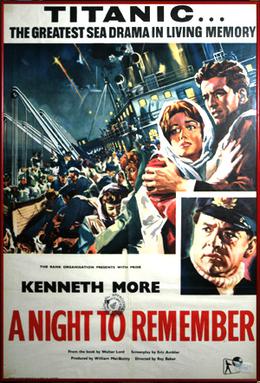
A Night to Remember is a 1958 British historical disaster docudrama film based on the eponymous 1955 book by Walter Lord. The film and book recount the final night of RMS Titanic, which sank on her maiden voyage after she struck an iceberg in 1912. Adapted by Eric Ambler and directed by Roy Ward Baker, the film stars Kenneth More as the ship's Second Officer Charles Lightoller and features Michael Goodliffe, Laurence Naismith, Kenneth Griffith, David McCallum and Tucker McGuire. It was filmed in the United Kingdom and tells the story of the sinking, portraying the main incidents and players in a documentary-style fashion with considerable attention to detail. The production team, supervised by producer William MacQuitty used blueprints of the ship to create authentic sets, while Fourth Officer Joseph Boxhall and ex-Cunard Commodore Harry Grattidge worked as technical advisors on the film. Its estimated budget of up to £600,000 was exceptional and made it the most expensive film ever made in Britain up to that time. The film's score was written by William Alwyn.

The Titanic has played a prominent role in popular culture since her sinking in 1912, with the loss of over 1,500 of the 2,200 lives on board. The disaster and the Titanic herself have been objects of public fascination for many years. They have inspired numerous books, plays, films, songs, poems, and works of art. The story has been interpreted in many overlapping ways, including as a symbol of technological hubris, as basis for fail-safe improvements, as a classic disaster tale, as an indictment of the class divisions of the time, and as romantic tragedies with personal heroism. It has inspired many moral, social and political metaphors and is regularly invoked as a cautionary tale of the limitations of modernity and ambition.

John Borland "Jack" Thayer III was a first-class passenger on RMS Titanic who survived the ship's sinking. Aged 17 at the time, he was one of only a handful of passengers to survive jumping into the frigid ocean. He later wrote and privately published his recollection of the sinking.

RMS Titanic sank on 15 April 1912 in the North Atlantic Ocean. The largest ocean liner in service at the time, Titanic was four days into her maiden voyage from Southampton to New York City, with an estimated 2,224 people on board when she struck an iceberg at 23:40 on 14 April. Her sinking two hours and forty minutes later at 02:20 ship's time on 15 April, resulted in the deaths of more than 1,500 people, making it one of the deadliest peacetime maritime disasters in history.

The Allison family was a Canadian family of first-class passengers on board the RMS Titanic, which struck an iceberg and sank on 15 April 1912.
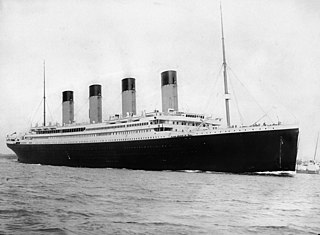
RMS Titanic was a British ocean liner that sank on 15 April 1912 as a result of striking an iceberg on her maiden voyage from Southampton, England to New York City, United States. Of the estimated 2,224 passengers and crew aboard, 1,496 died, making the incident the deadliest sinking of a single ship at the time. Titanic, operated by the White Star Line, carried some of the wealthiest people in the world, as well as hundreds of emigrants from the British Isles, Scandinavia, and elsewhere in Europe who were seeking a new life in the United States and Canada. The disaster drew public attention, spurred major changes in maritime safety regulations, and inspired a lasting legacy in popular culture.

Titanic II is a 2010 American drama disaster film written, directed by and starring Shane Van Dyke and distributed by The Asylum. Despite the title, it is not a sequel to the 1997 critically acclaimed film, but is a mockbuster of it. It was released direct-to-TV in Australia on 7 August 2010. It premiered on Syfy, on Sky in the UK and Ireland on 9 August. It was released on 25 August in the United States to critically negative response, though the film's ensemble cast performances, particularly that of Bruce Davison, received praise.

There have been several legends and myths surrounding the RMS Titanic and its destruction after colliding with an iceberg in the Atlantic Ocean. These have ranged from stories involving the myth about the ship having been described as "unsinkable" to the myth concerning the final song played by the ship's musicians.
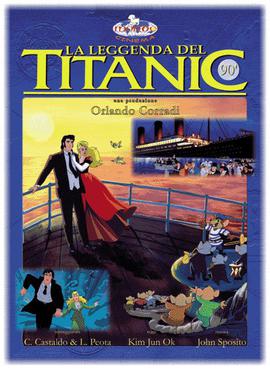
The Legend of the Titanic is a 1999 animated fantasy film directed by Orlando Corradi and Kim J. Ok. The film is a very loose adaptation of the RMS Titanic sinking and featured several fantasy elements such as anthropomorphic animals.

Mime Misu was a Romanian ballet dancer, pantomime artist, film actor and director. In 1912 he wrote and directed the first feature film about the sinking of the RMS Titanic, In Nacht und Eis, released in August 1912 four months after the disaster.

Continental-Kunstfilm GmbH was a short-lived German film production company based in Berlin, formed in February 1912 by Walter Schmidthässler and Max Rittberger. A large number of Continental-Kunstfilm's productions are now probably lost, although some significant films have survived into the 21st century.

Otto Rippert was a German film director during the silent film era.




















